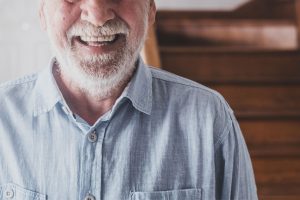My sponsor replied, “In OA, we say, ‘Put down the fork and work the Steps.’ Apparently, you’ve put down the fork with your surgery. We will start the Steps next week, and I hope you’ll accompany us through the end of the all Twelve Steps.
I joined OA after undergoing weight loss surgery, exactly when I had reached a healthy weight and was no longer the obese, forty-something man I used to be. A friend had suggested OA because I had inner feelings of inadequacy and had already tried various ways to address those feelings, including reading psychology and philosophy books and seeking therapy. Learning about the characteristics of compulsive overeating was intriguing, but when I heard other OA members talk about their food and weight, my thought was that it didn’t appeal or apply to me. Since I had undergone surgery, I thought I wouldn’t become obese again, so I didn’t need OA!
But about a month into joining this community, I realized there was something in the universe called the Twelve Steps. I started searching for a guide in the online meetings, and that’s when an OA member suggested I start praying to find a sponsor. I prayed, but I was doubtful. A few days later, I attended a meeting where there were only six of us. I wondered how I could possibly find a sponsor in this small group when I hadn’t succeeded in larger meetings. It was a literature meeting, and someone read from the OA Twelve and Twelve, “Many of us held responsible jobs and ran our households with reasonable success. We had friends who liked us, and many of us had fairly good marriages. That these didn’t make us happy was surely due to the fact that we were fat (or felt we were).” (p. 5). In fact, this paragraph beautifully described my entire adult life! Later in the meeting, another member shared their experience and said, “In addition to overeating, we can have other negative traits, such as talkativeness and greediness, and alongside the negative traits, we can have positive traits, like kindness and talent.” The very same traits he described were the ones that had plagued my life! I had been the hero of others’ lives and the failure of my own life. I believe the distresses of countlessly stepping in to rescue others while failing to help myself is what drew me into this community. OA miracles happen in such strange ways.
I chose the member who shared that day to be my sponsor and asked them this question: Even if I want to eat, I physically can’t because of my surgery! How can OA help me?
Having an aware sponsor in the OA program is a blessing and a gift from God. My sponsor replied, “In OA, we say, ‘Put down the fork and work the Steps.’ Apparently, you’ve put down the fork with your surgery. We will start the Steps next week, and I hope you’ll accompany us through the end of the all Twelve Steps. When the compulsive eating behaviors stop, you’ll work on healing the overeater, and then you will receive answers that will calm not only your mind but also your heart. ”
I have worked all Twelve Steps twice since then and taken a sponsee through the Steps once. What I’ve learned is that Steps One, Two, and Three help us stop compulsive eating and compulsive food behaviors and also help identify that there’s a “shadow” that follows compulsive eating:
In Step One, I realized that my compulsive overeating was a representative display of my entire life: my compulsive eating behaviors mirrored broader traits that were also a problem. For example, my fast eating is a compulsive food behavior, but I also display hastiness in other ways. When my disorder stops, my fast eating stops, but my hastiness does not, especially when my recovery is not strong. My hastiness needs a spiritual healing.
In Step Two, I realized that my compulsive eating had affected my beliefs, thoughts, and attitudes. My compulsion led me to believe that I shouldn’t waste food and should eat out of pity. But the similar overreach of responsibility and sense of ownership I have displayed towards my loved ones also comes from the same compulsion.
In Step Three, I realized that to stop my compulsive eating disorder, I needed to design a dietary plan for abstinence and commit spiritually to implementing it with the help of my sponsor. But my mistrust in handing over my plans to the Higher Power was also part of my compulsion.
To fully overcome the compulsion and heal the overeater not only physically but emotionally and spiritually, we work the next eight Steps:
Step Four is the beginning of a journey towards healing for the overeater. I used a Fourth Step inventory worksheet to identify four main emotions: pride, fear, shame, and guilt. And I inventoried my reactions resulting from distress, anger, and negative thoughts. I realized that since childhood I had been using these scenarios to reach a bad state, which always culminated in the soothing comfort of food. However, even after I had completed a Step Four inventory, I could still experience cycles of emotions and turmoil. So Step Four was how I started to emerge from my own prison. That was where I first understood how an overeater can consume both food and his companions.
Step Four is the beginning of a journey towards healing for the overeater. . . . Step Four was how I started to emerge from my own prison.
It wasn’t until Step Five that I experienced the cessation of my compulsive eating disorder. Abstinence was a great blessing for me. Step Five was the beginning of amending my relationships with food, myself, God, and others.
In Steps Six through Nine, I learned about and worked on the subtleties of emotional recovery. Working these Steps was like putting on glasses that revealed a world full of people consuming the venom of their defects of character and eating over everything. I reflected on the Step Six question about defects of character, “Now we ask ourselves what is it doing for us as well as what is it doing to us” (OA Twelve and Twelve, p. 56). I realized that until the overeater overcomes their barriers to humility and their defects are removed, food will remain as a suitable means to fill the void. I understood what feelings lurk behind each behavioral pattern, the same feelings that had long been numbed with food. If they are not addressed, not only minor eating but also other minor compulsive behaviors can lead to a slip or relapse or harm to my relationships.
Working Steps Six through Nine created such clarity for me that in Step Ten, I realized how just one untreated thought, feeling, or behavior can create a bad day for a compulsive overeater.
Through Step Eleven, I came to understand conscious contact with my Higher Power in a way that was incomprehensible to me when I was compulsively overeating. Food was transformed from a sedative and narcotic to a blessing for this recovering compulsive overeater to have the necessary energy to fulfill God’s desires. Meditation has changed the direction of my thoughts so the disorder does not become active.
In Step Twelve, I learned that my compulsive hunger had its roots in spiritual hunger, and to find healing, I must always be connected to the source of God’s love and apply Spiritual Principles in all aspects of life.
I don’t know if it was your prayer for still-suffering overeaters or my own heartfelt prayer that brought me to Overeaters Anonymous. Whatever it was, I thank God I’m here.
—Kaveh, Tehran, Iran





